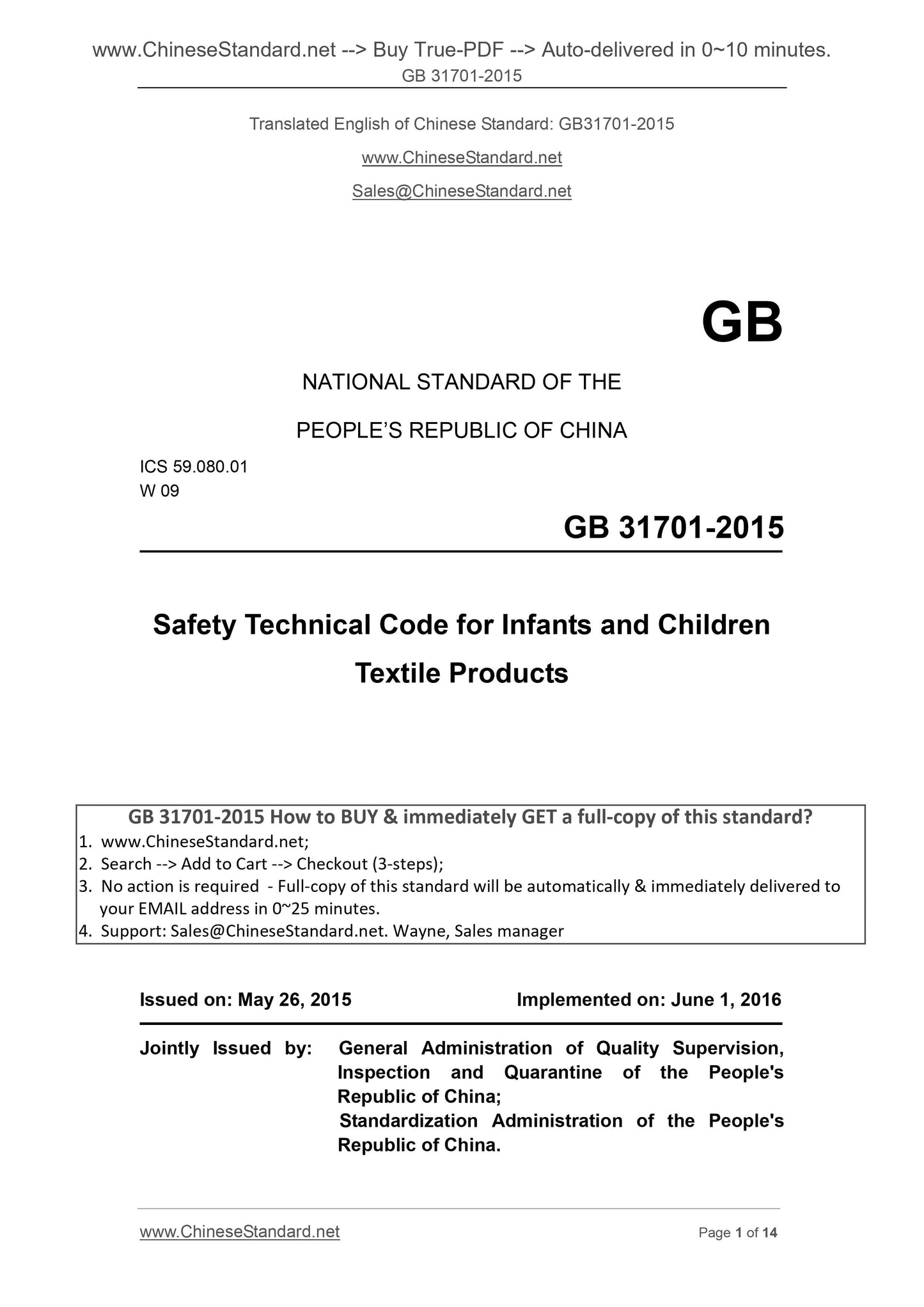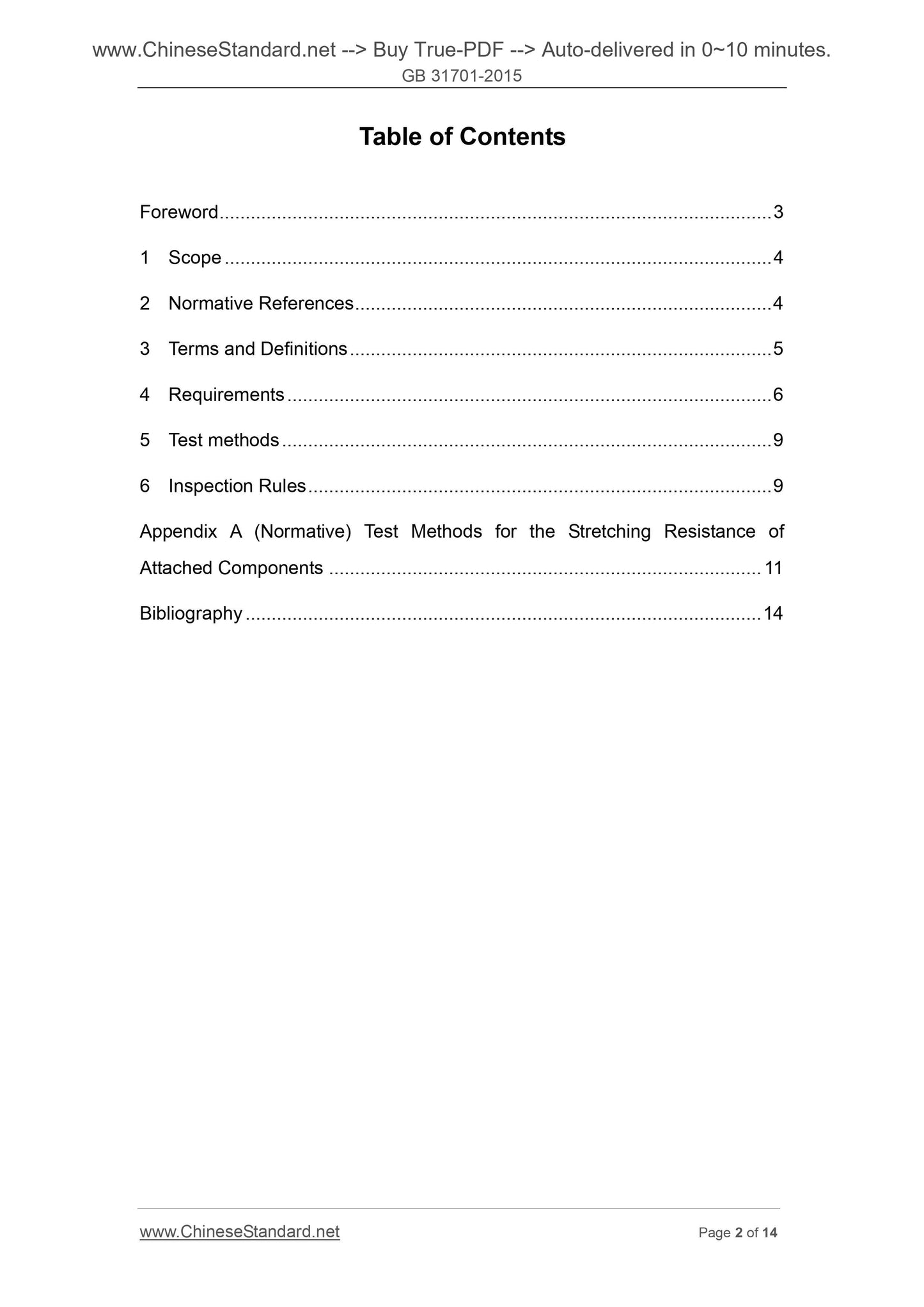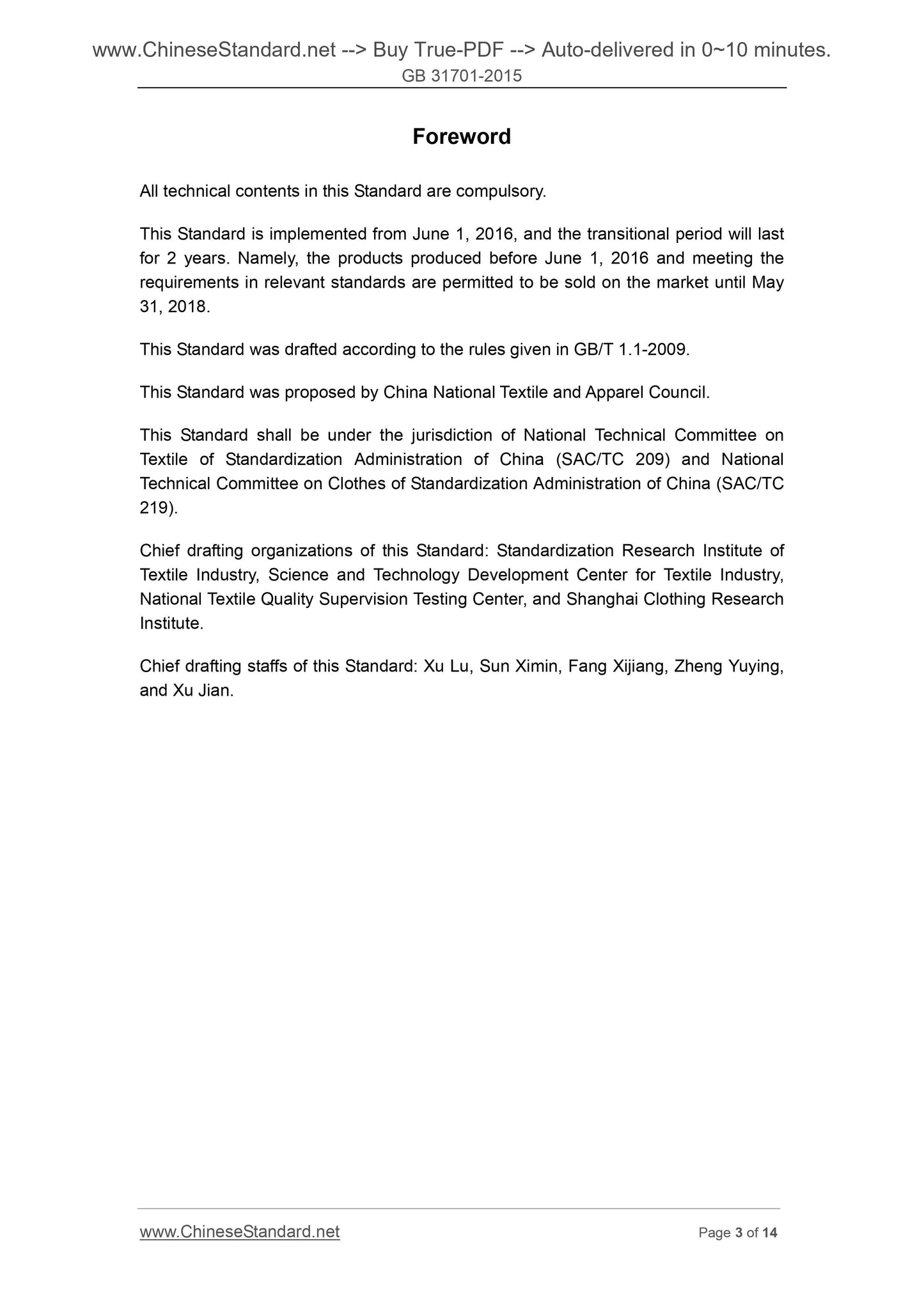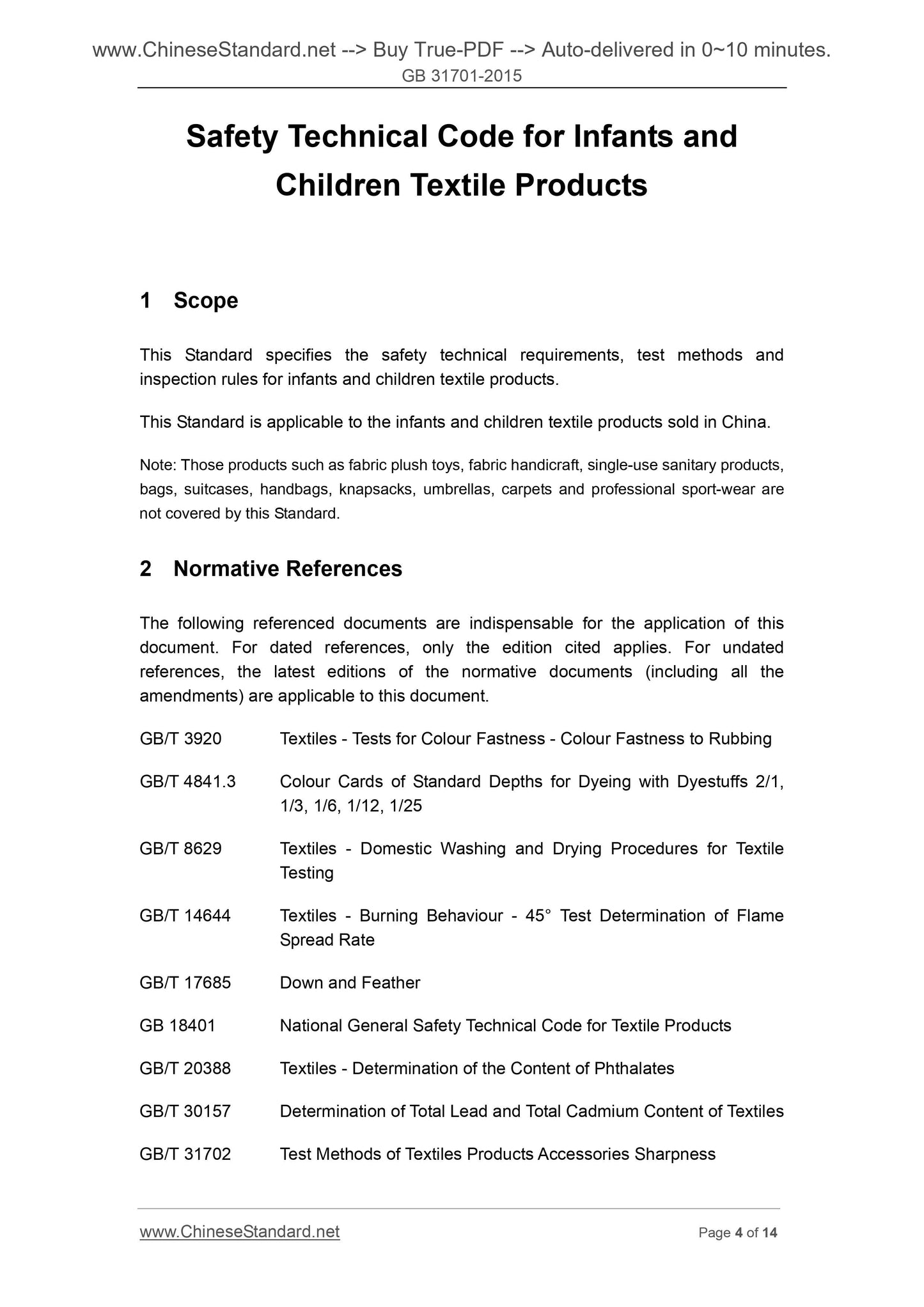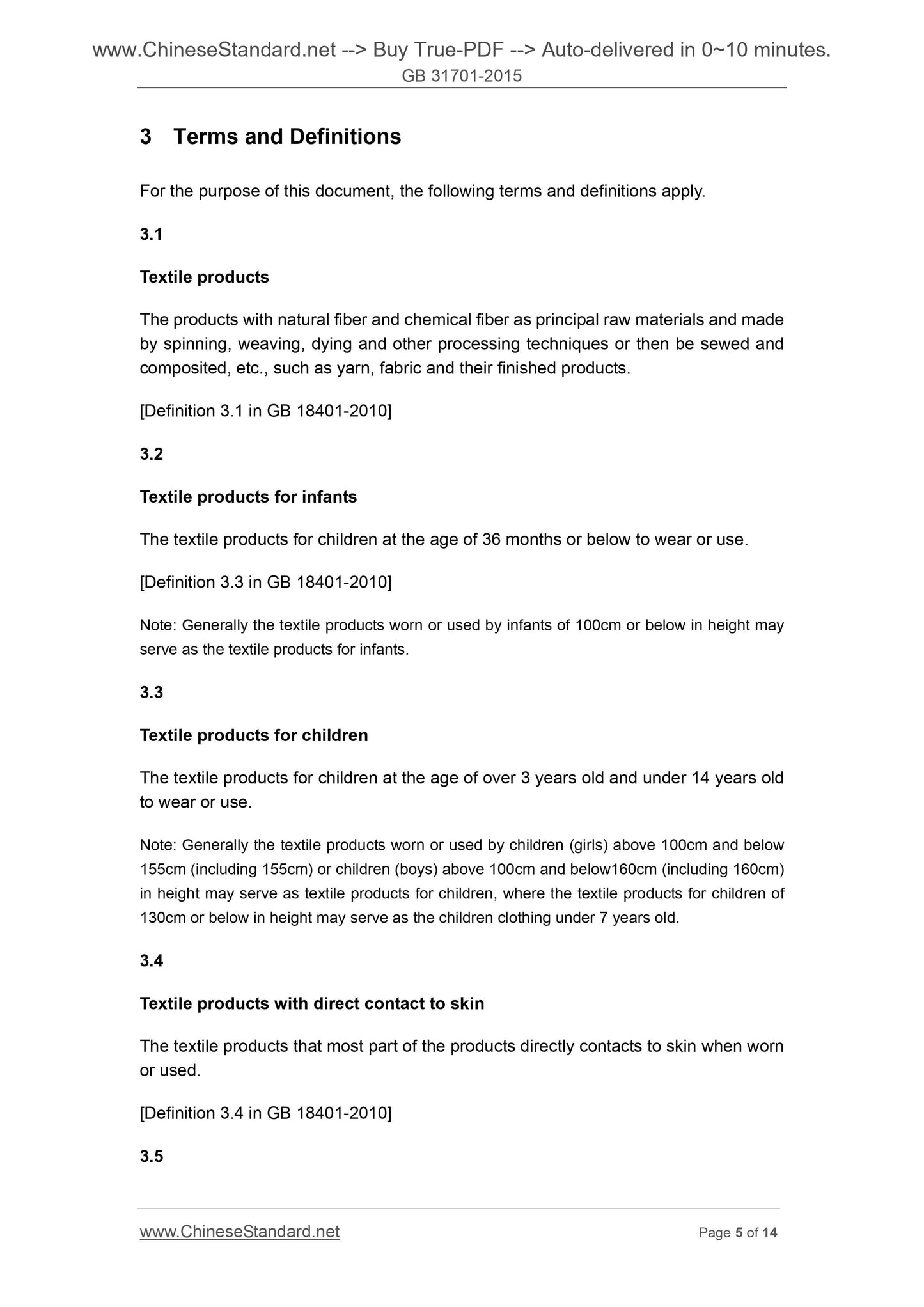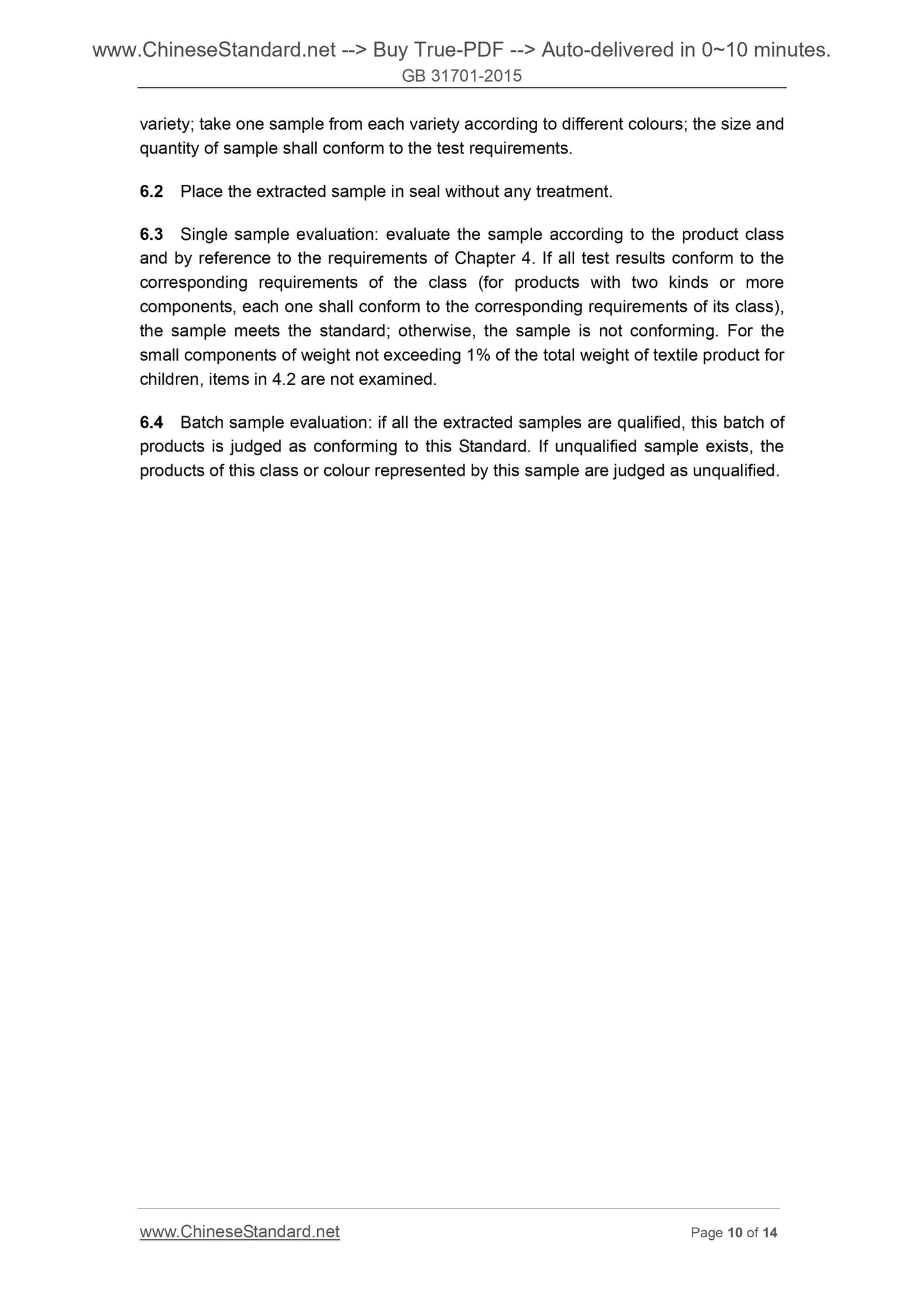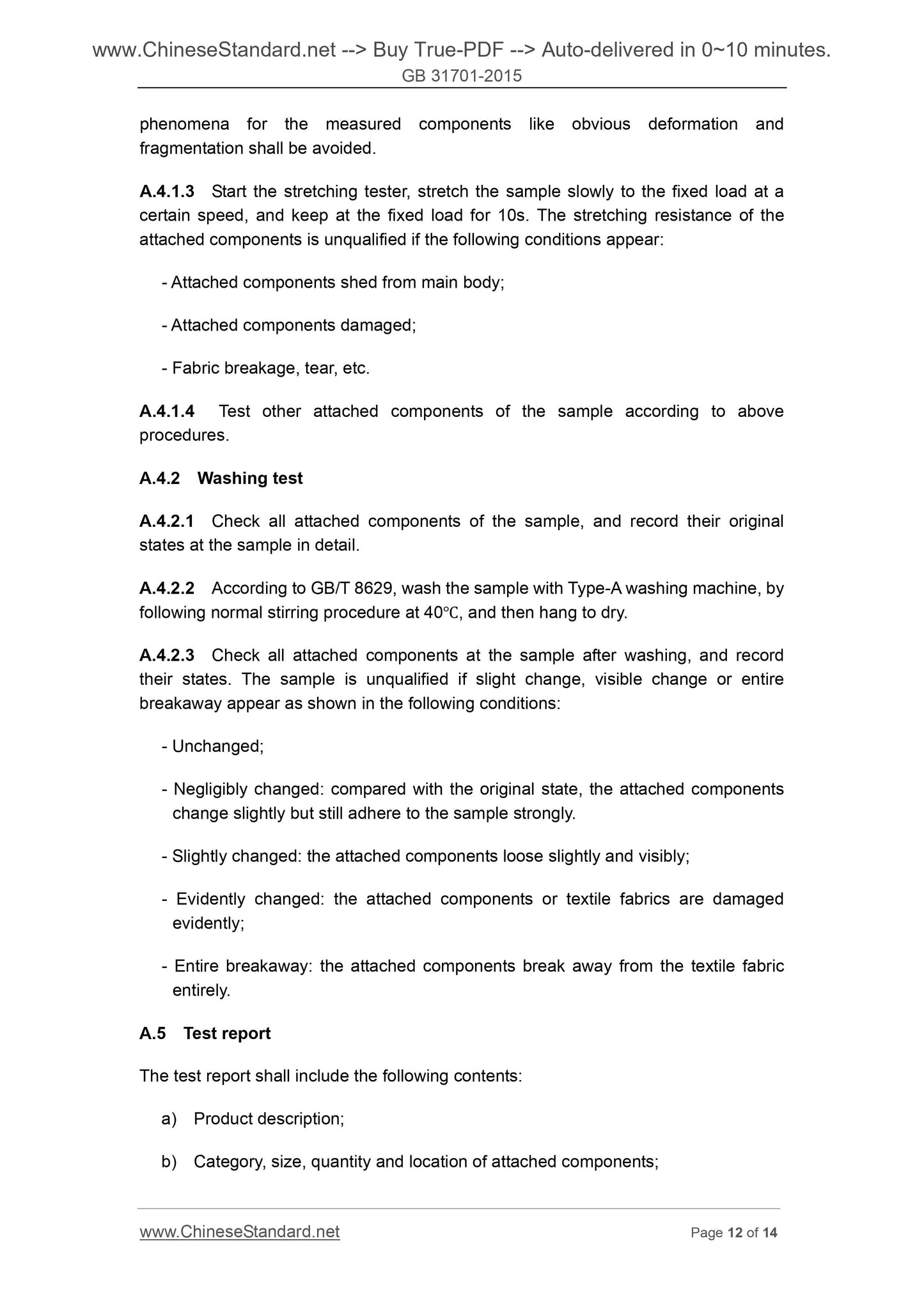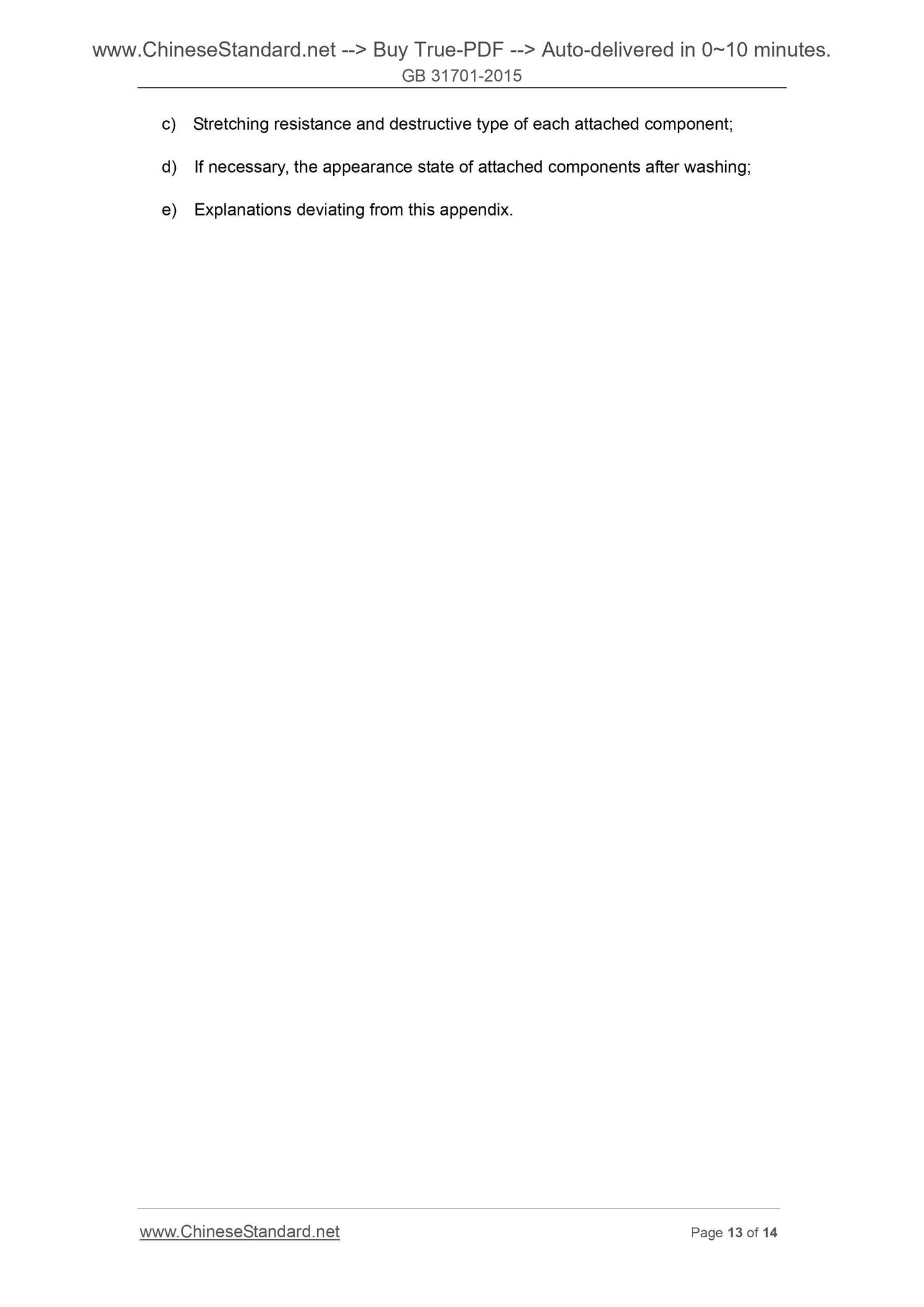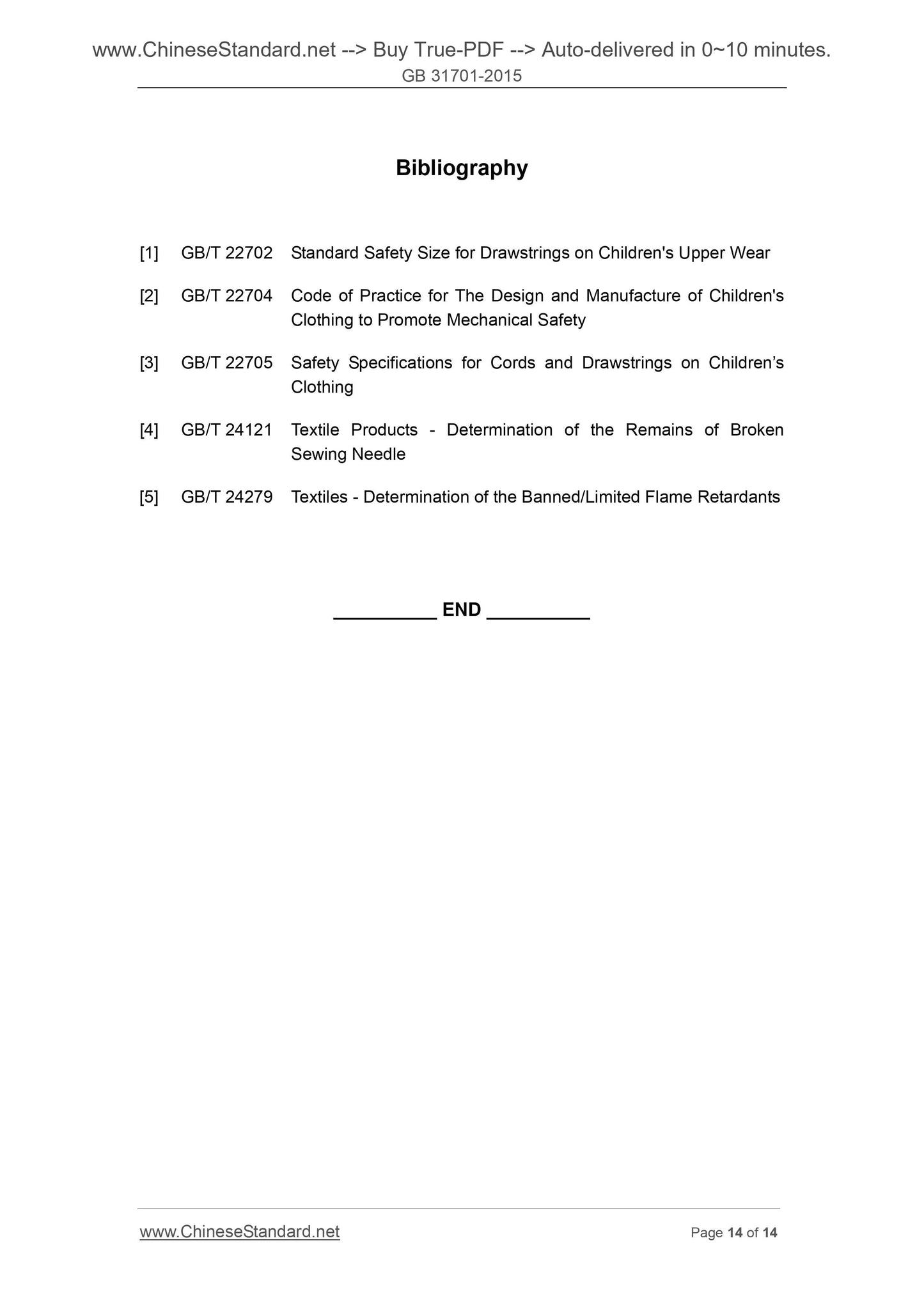1
/
of
9
PayPal, credit cards. Download editable-PDF & invoice in 1 second!
GB 31701-2015 English PDF (GB31701-2015)
GB 31701-2015 English PDF (GB31701-2015)
Regular price
$85.00 USD
Regular price
Sale price
$85.00 USD
Unit price
/
per
Shipping calculated at checkout.
Couldn't load pickup availability
Delivery: 3 seconds. Download true-PDF + Invoice.
Get QUOTATION in 1-minute: Click GB 31701-2015
Historical versions: GB 31701-2015
Preview True-PDF (Reload/Scroll if blank)
GB 31701-2015: Safety technical code for infants and children textile products
GB 31701-2015
GB
NATIONAL STANDARD OF THE
PEOPLE’S REPUBLIC OF CHINA
ICS 59.080.01
W 09
Safety Technical Code for Infants and Children
Textile Products
ISSUED ON. MAY 26, 2015
IMPLEMENTED ON. JUNE 1, 2016
Jointly Issued by. General Administration of Quality Supervision,
Inspection and Quarantine of the People's
Republic of China;
Standardization Administration of the People's
Republic of China.
Table of Contents
Foreword ... 3
1 Scope ... 4
2 Normative References ... 4
3 Terms and Definitions ... 5
4 Requirements ... 6
5 Test methods ... 9
6 Inspection Rules ... 9
Appendix A (Normative) Test Methods for the Stretching Resistance of
Attached Components ... 11
Bibliography ... 14
Foreword
All technical contents in this Standard are compulsory.
This Standard is implemented from June 1, 2016, and the transitional period will last
for 2 years. Namely, the products produced before June 1, 2016 and meeting the
requirements in relevant standards are permitted to be sold on the market until May
31, 2018.
This Standard was drafted according to the rules given in GB/T 1.1-2009.
This Standard was proposed by China National Textile and Apparel Council.
This Standard shall be under the jurisdiction of National Technical Committee on
Textile of Standardization Administration of China (SAC/TC 209) and National
Technical Committee on Clothes of Standardization Administration of China (SAC/TC
219).
Chief drafting organizations of this Standard. Standardization Research Institute of
Textile Industry, Science and Technology Development Center for Textile Industry,
National Textile Quality Supervision Testing Center, and Shanghai Clothing Research
Institute.
Chief drafting staffs of this Standard. Xu Lu, Sun Ximin, Fang Xijiang, Zheng Yuying,
and Xu Jian.
Safety Technical Code for Infants and
Children Textile Products
1 Scope
This Standard specifies the safety technical requirements, test methods and
inspection rules for infants and children textile products.
This Standard is applicable to the infants and children textile products sold in China.
Note. Those products such as fabric plush toys, fabric handicraft, single-use sanitary products,
bags, suitcases, handbags, knapsacks, umbrellas, carpets and professional sport-wear are
not covered by this Standard.
2 Normative References
The following referenced documents are indispensable for the application of this
document. For dated references, only the edition cited applies. For undated
references, the latest editions of the normative documents (including all the
amendments) are applicable to this document.
GB/T 3920 Textiles - Tests for Colour Fastness - Colour Fastness to Rubbing
GB/T 4841.3 Colour Cards of Standard Depths for Dyeing with Dyestuffs 2/1,
1/3, 1/6, 1/12, 1/25
GB/T 8629 Textiles - Domestic Washing and Drying Procedures for Textile
Testing
GB/T 14644 Textiles - Burning Behaviour - 45° Test Determination of Flame
Spread Rate
GB/T 17685 Down and Feather
GB 18401 National General Safety Technical Code for Textile Products
GB/T 20388 Textiles - Determination of the Content of Phthalates
GB/T 30157 Determination of Total Lead and Total Cadmium Content of Textiles
GB/T 31702 Test Methods of Textiles Products Accessories Sharpness
3 Terms and Definitions
For the purpose of this document, the following terms and definitions apply.
3.1
Textile products
The products with natural fiber and chemical fiber as principal raw materials and made
by spinning, weaving, dying and other processing techniques or then be sewed and
composited, etc., such as yarn, fabric and their finished products.
[Definition 3.1 in GB 18401-2010]
3.2
Textile products for infants
The textile products for children at the age of 36 months or below to wear or use.
[Definition 3.3 in GB 18401-2010]
Note. Generally the textile products worn or used by infants of 100cm or below in height may
serve as the textile products for infants.
3.3
Textile products for children
The textile products for children at the age of over 3 years old and under 14 years old
to wear or use.
Note. Generally the textile products worn or used by children (girls) above 100cm and below
155cm (including 155cm) or children (boys) above 100cm and below160cm (including 160cm)
in height may serve as textile products for children, where the textile products for children of
130cm or below in height may serve as the children clothing under 7 years old.
3.4
Textile products with direct contact to skin
The textile products that most part of the products directly contacts to skin when worn
or used.
[Definition 3.4 in GB 18401-2010]
3.5
variety; take one sample from each variety according to different colours; the size and
quantity of sample shall conform to the test requirements.
6.2 Place the extracted sample in seal without any treatment.
6.3 Single sample evaluation. evaluate the sample according to the product class
and by reference to the requirements of Chapter 4. If all test results conform to the
corresponding requirements of the class (for products with two kinds or more
components, each one shall conform to the corresponding requirements of its class),
the sample meets the standard; otherwise, the sample is not conforming. For the
small components of weight not exceeding 1% of the total weight of textile product for
children, items in 4.2 are not examined.
6.4 Batch sample evaluation. if all the extracted samples are qualified, this batch of
products is judged as conforming to this Standard. If unqualified sample exists, the
products of this class or colour represented by this sample are judged as unqualified.
phenomena for the measured components like obvious deformation and
fragmentation shall be avoided.
A.4.1.3 Start the stretching tester, stretch the sample slowly to the fixed load at a
certain speed, and keep at the fixed load for 10s. The stretching resistance of the
attached components is unqualified if the following conditions appear.
- Attached components shed from main body;
- Attached components damaged;
- Fabric breakage, tear, etc.
A.4.1.4 Test other attached components of the sample according to above
procedures.
A.4.2 Washing test
A.4.2.1 Check all attached components of the sample, and record their original
states at the sample in detail.
A.4.2.2 According to GB/T 8629, wash the sample with Type-A washing machine, by
following normal stirring procedure at 40Ԩ, and then hang to dry.
A.4.2.3 Check all attached components at the sample after washing, and record
their states. The sample is unqualified if slight change, visible change or entire
breakaway appear as shown in the following conditions.
- Unchanged;
- Negligibly changed. compared with the original state, the attached components
change slightly but still adhere to the sample strongly.
- Slightly changed. the attached components loose slightly and visibly;
- Evidently changed. the attached components or textile fabrics are damaged
evidently;
- Entire breakaway. the attached components break away from the textile fabric
entirely.
A.5 Test report
The test report shall include the following contents.
a) Product description;
b) Category, size, quantity and location of attached components;
c) Stretching resistance and destructive type of each attached component;
d) If necessary, the appearance state of attac...
Get QUOTATION in 1-minute: Click GB 31701-2015
Historical versions: GB 31701-2015
Preview True-PDF (Reload/Scroll if blank)
GB 31701-2015: Safety technical code for infants and children textile products
GB 31701-2015
GB
NATIONAL STANDARD OF THE
PEOPLE’S REPUBLIC OF CHINA
ICS 59.080.01
W 09
Safety Technical Code for Infants and Children
Textile Products
ISSUED ON. MAY 26, 2015
IMPLEMENTED ON. JUNE 1, 2016
Jointly Issued by. General Administration of Quality Supervision,
Inspection and Quarantine of the People's
Republic of China;
Standardization Administration of the People's
Republic of China.
Table of Contents
Foreword ... 3
1 Scope ... 4
2 Normative References ... 4
3 Terms and Definitions ... 5
4 Requirements ... 6
5 Test methods ... 9
6 Inspection Rules ... 9
Appendix A (Normative) Test Methods for the Stretching Resistance of
Attached Components ... 11
Bibliography ... 14
Foreword
All technical contents in this Standard are compulsory.
This Standard is implemented from June 1, 2016, and the transitional period will last
for 2 years. Namely, the products produced before June 1, 2016 and meeting the
requirements in relevant standards are permitted to be sold on the market until May
31, 2018.
This Standard was drafted according to the rules given in GB/T 1.1-2009.
This Standard was proposed by China National Textile and Apparel Council.
This Standard shall be under the jurisdiction of National Technical Committee on
Textile of Standardization Administration of China (SAC/TC 209) and National
Technical Committee on Clothes of Standardization Administration of China (SAC/TC
219).
Chief drafting organizations of this Standard. Standardization Research Institute of
Textile Industry, Science and Technology Development Center for Textile Industry,
National Textile Quality Supervision Testing Center, and Shanghai Clothing Research
Institute.
Chief drafting staffs of this Standard. Xu Lu, Sun Ximin, Fang Xijiang, Zheng Yuying,
and Xu Jian.
Safety Technical Code for Infants and
Children Textile Products
1 Scope
This Standard specifies the safety technical requirements, test methods and
inspection rules for infants and children textile products.
This Standard is applicable to the infants and children textile products sold in China.
Note. Those products such as fabric plush toys, fabric handicraft, single-use sanitary products,
bags, suitcases, handbags, knapsacks, umbrellas, carpets and professional sport-wear are
not covered by this Standard.
2 Normative References
The following referenced documents are indispensable for the application of this
document. For dated references, only the edition cited applies. For undated
references, the latest editions of the normative documents (including all the
amendments) are applicable to this document.
GB/T 3920 Textiles - Tests for Colour Fastness - Colour Fastness to Rubbing
GB/T 4841.3 Colour Cards of Standard Depths for Dyeing with Dyestuffs 2/1,
1/3, 1/6, 1/12, 1/25
GB/T 8629 Textiles - Domestic Washing and Drying Procedures for Textile
Testing
GB/T 14644 Textiles - Burning Behaviour - 45° Test Determination of Flame
Spread Rate
GB/T 17685 Down and Feather
GB 18401 National General Safety Technical Code for Textile Products
GB/T 20388 Textiles - Determination of the Content of Phthalates
GB/T 30157 Determination of Total Lead and Total Cadmium Content of Textiles
GB/T 31702 Test Methods of Textiles Products Accessories Sharpness
3 Terms and Definitions
For the purpose of this document, the following terms and definitions apply.
3.1
Textile products
The products with natural fiber and chemical fiber as principal raw materials and made
by spinning, weaving, dying and other processing techniques or then be sewed and
composited, etc., such as yarn, fabric and their finished products.
[Definition 3.1 in GB 18401-2010]
3.2
Textile products for infants
The textile products for children at the age of 36 months or below to wear or use.
[Definition 3.3 in GB 18401-2010]
Note. Generally the textile products worn or used by infants of 100cm or below in height may
serve as the textile products for infants.
3.3
Textile products for children
The textile products for children at the age of over 3 years old and under 14 years old
to wear or use.
Note. Generally the textile products worn or used by children (girls) above 100cm and below
155cm (including 155cm) or children (boys) above 100cm and below160cm (including 160cm)
in height may serve as textile products for children, where the textile products for children of
130cm or below in height may serve as the children clothing under 7 years old.
3.4
Textile products with direct contact to skin
The textile products that most part of the products directly contacts to skin when worn
or used.
[Definition 3.4 in GB 18401-2010]
3.5
variety; take one sample from each variety according to different colours; the size and
quantity of sample shall conform to the test requirements.
6.2 Place the extracted sample in seal without any treatment.
6.3 Single sample evaluation. evaluate the sample according to the product class
and by reference to the requirements of Chapter 4. If all test results conform to the
corresponding requirements of the class (for products with two kinds or more
components, each one shall conform to the corresponding requirements of its class),
the sample meets the standard; otherwise, the sample is not conforming. For the
small components of weight not exceeding 1% of the total weight of textile product for
children, items in 4.2 are not examined.
6.4 Batch sample evaluation. if all the extracted samples are qualified, this batch of
products is judged as conforming to this Standard. If unqualified sample exists, the
products of this class or colour represented by this sample are judged as unqualified.
phenomena for the measured components like obvious deformation and
fragmentation shall be avoided.
A.4.1.3 Start the stretching tester, stretch the sample slowly to the fixed load at a
certain speed, and keep at the fixed load for 10s. The stretching resistance of the
attached components is unqualified if the following conditions appear.
- Attached components shed from main body;
- Attached components damaged;
- Fabric breakage, tear, etc.
A.4.1.4 Test other attached components of the sample according to above
procedures.
A.4.2 Washing test
A.4.2.1 Check all attached components of the sample, and record their original
states at the sample in detail.
A.4.2.2 According to GB/T 8629, wash the sample with Type-A washing machine, by
following normal stirring procedure at 40Ԩ, and then hang to dry.
A.4.2.3 Check all attached components at the sample after washing, and record
their states. The sample is unqualified if slight change, visible change or entire
breakaway appear as shown in the following conditions.
- Unchanged;
- Negligibly changed. compared with the original state, the attached components
change slightly but still adhere to the sample strongly.
- Slightly changed. the attached components loose slightly and visibly;
- Evidently changed. the attached components or textile fabrics are damaged
evidently;
- Entire breakaway. the attached components break away from the textile fabric
entirely.
A.5 Test report
The test report shall include the following contents.
a) Product description;
b) Category, size, quantity and location of attached components;
c) Stretching resistance and destructive type of each attached component;
d) If necessary, the appearance state of attac...
Share
